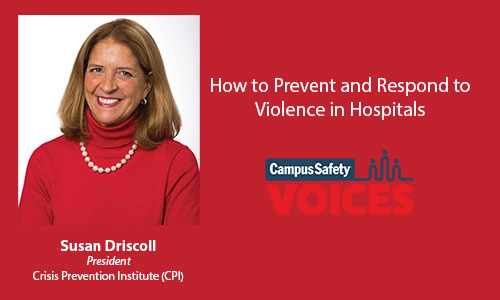In 2019, 20,870 workers in the private industry experienced trauma from workplace violence, according to the Bureau of Labor Statistics. Of those employees, 70% worked in the healthcare and social service industries.
From 2020 to 2021, the IAHSS Foundation 2022 Crime Survey found the rate of hospital violent crime increased by 47%. Although there are exceptions, most patients or visitors are at hospitals for non-joyous occasions, making them more prone to feeling anxious. Add to the mix the collective trauma experienced by so many people in the last two-and-a-half years, and violent incidents are pouring into areas of hospitals that aren’t used to seeing it.
“[Incidents of workplace violence] used to be in behavioral health wards, emergency departments or actually pediatric intensive care is another one — where there are emotionally charged situations and people with very little patience — that’s where it would happen more frequently,” Susan Driscoll, president of the Crisis Prevention Institute (CPI), told Campus Safety. “But now it’s happening everywhere. Anywhere there is someone who has escalated emotions, combined with workers who are overworked and exhausted, and that may not be able to fully regulate their emotions, that’s sort of like a powder keg for a crisis moment.”
To address workplace violence incidents, the Joint Commission came out with new hospital accreditation requirements. The new standards, which went into effect on Jan. 1, 2022, call for hospitals to have a workplace violence prevention program led by a designated individual but developed by a multidisciplinary team. Hospitals are now required to provide training, education, and resources for the prevention of workplace violence to leadership, staff, and licensed practitioners.
CPI provides training to various industries to help workplaces establish sustainable cultures of safety. The institute teaches people how to recognize escalating behaviors and arms them with practical de-escalation skills.
“By understanding the level that they’re at of escalation and responding appropriately, you can actually control the situation,” said Driscoll. “It puts much more confidence and control back in the hands of the worker.”
Studies have shown that workplace violence is directly correlated to higher nurse turnover. Therefore, de-escalation training not only protects employees but it saves hospitals money.
“Ninety-five percent of people who go through our training say they feel more confident and competent to control these situations and there is overall an 82% decline in workplace comp claims for people who fully embed our training, so there’s real savings there,” Driscoll said. “It costs about $82,000 to replace a nurse, and when you’re short-staffed, you’re more likely to have serious issues, so there’s a cost to that too. I think many administrators don’t fully understand the direct correlation between training and profitability for the hospital, honestly.”
Tips for De-Escalation and Preventing Crisis Moments
While each potential crisis is different, there are several strategies that have proven to work in most situations. CPI’s various trainings teach the four distinct stages of a crisis:
- Anxiety
- Defensive behavior
- Risk-level behavior
- Tension reduction
Driscoll’s biggest piece of advice for avoiding a crisis is to practice seeing the early signs of anxiety and offering support.
“If you start to practice that early recognition and understanding the appropriate response — empathy, support, calm your voice, get control of your own emotions — and practice it when there’s not an emergency, then you’re going to be more prepared,” she emphasized.”That skills practice muscle memory is super important.”
Next, if during a potential emergency you don’t feel in control, ask for help.
“We really encourage the team approach both because if you’re not feeling completely in control of yourself, you’re not going to be able to manage the behavior of someone else, so ask for help there,” Driscoll added. “Take a few moments to do some deep breathing to try to get in control.”
Driscoll also says hospital staff should be aware of the fact that some characteristics they possess, to no fault of their own, might be what is triggering anxiety in a patient or visitor.
“Many people who reach [escalating] behavior have trauma in their backgrounds and you are a trigger. You are a trigger and you don’t even know it, for no other reason than the way you look or what you remind that person of,” she said. “When it seems like you’re doing the right thing but you can’t control it, get somebody else in there and assume that you’re a trigger for a traumatic experience.”
Conversely, Driscoll says, nurses have trauma as well, and if a patient is a trigger for you, ask for help.
For more tips and free resources, CPI has created a landing page for Campus Safety readers, more specifically for those who are hospital security directors. Check it out at www.cpisite.com/campussafety.
Additional topics discussed in Driscoll’s interview include:
- How the pandemic has positively impacted hospital safety (5:11)
- The importance of having a unified approach to de-escalation, no matter what a person’s job role is within a hospital (12:51)
- The importance of data collection and reporting workplace violence incidents (17:19)
- What a typical CPI course is like (19:12)
Watch our full interview here or listen on the go on Apple or Spotify.









